
Websites allow users to access your website from anywhere in the world. A small eCommerce site in Florida can just as easily reach a businessman in India as a family in South Carolina. Even if you have a “.com” English-only site, you may very well be an international business by default.
The problem?
Those people live very different lives.
They differ in many aspects, from gender to age, how they got to your site, even what images they prefer. More significantly, they come from different countries, speak different languages, have different currencies, and have an assortment of different cultural expectations.
How can you use your existing infrastructure and marketing efforts to cater to such a large audience? How can you make sure that your traffic is really getting the most relevant content leading to a conversion?
The answer is geo-targeting.
What is Geo-Targeting?
Geo-targeting is an active response to a user’s geographical location. Once a site or a platform determines a visitor’s location based on their IP address, Wi-Fi, or GPS data, content specific to that location is delivered. This location can be a country, state, city, and more.
The simplest examples of geo-targeting are right in the SERPs. You might not have even noticed the.
Here is a search on Google.com for “Italian restaurants” from users in Florida:
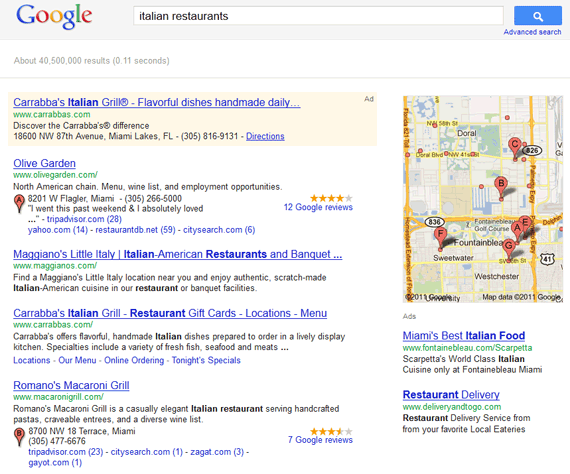
Notice all the locations are in Florida.
Here’s another example, this time from near London, UK:
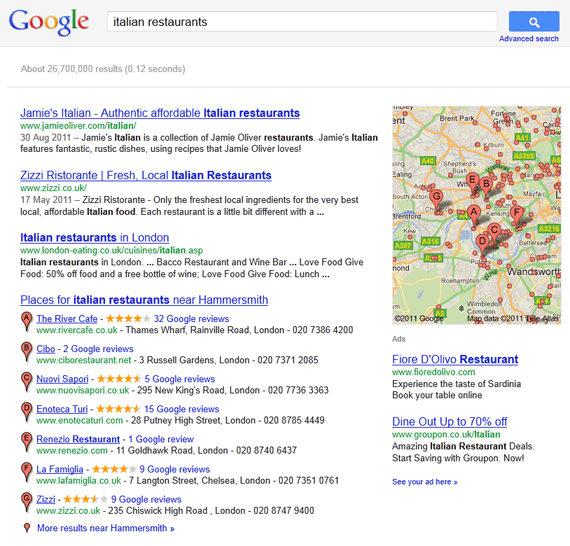
As you can see, the results are specific to the location. Google knows where they are and aims to deliver more relevant results, which drives conversions.
Here’s another example of geo-targeting with on-site content:
This is Herz.com viewed from Singapore:
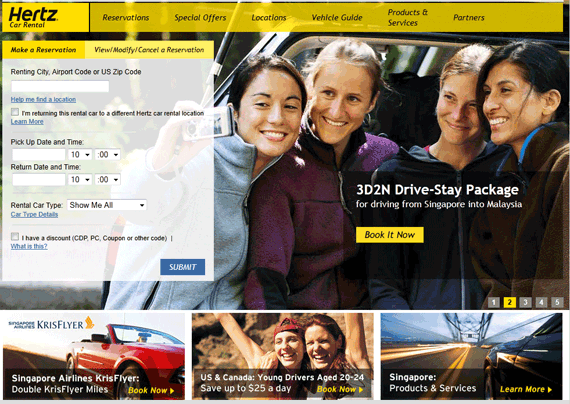
Same site, but from a user in Chile:
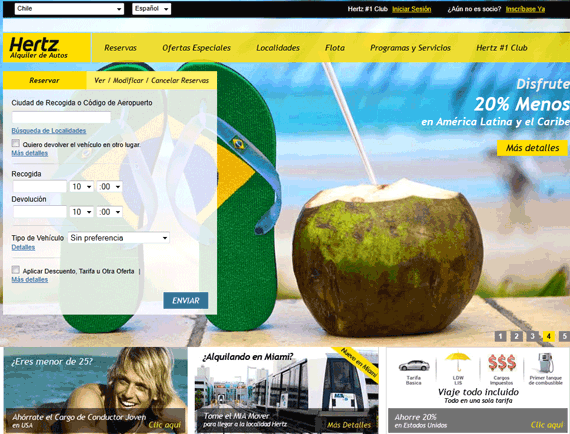
Spot the difference? The site adjusted not just the language but also the pictures and copy as well. Both are on the same domain, but the content is far different.
Why Does Geo-Targeting Matter?
Testing different ideas and approaches when location is taken into account can create very interesting insights–and often much different conversion rates.
What will work better for your funnel – showing your traffic from Spain pages in Spanish or English? Will you quote Euro or Dollar?
People expect content to be personalized to them, and geo-targeting is one way to deliver more accurate and relevant content. It’s not just great for users; personalized content drives sales.
5 Geo-Targeting Tests to Drive Conversions
Here are five geo-targeting tests you can try to see if they increase your conversions.
1. Experiment With Languages
Match the page language to the visitor’s country of origin. (I do suggest allowing a language switch, just in case.) Measure what converts better.
You can test the entire funnel in different languages or test a specific KPI on the page (CTA click, time on site, etc.) and measure its performance.
For example, visiting Samsung.com from Hong Kong redirects to their smasung.com/hk directory, and the language is as expected. Finding the location change icon is fairly easy at the bottom left, as is the language switch at the top right of the main menu.

Visit Coca-Cola’s site in Germany, and you’ll see the site is in English. However, Germany is highlighted, making it easy for the user to switch. These splash screens are common for international sites, but whether they convert better is something you’ll need to test.
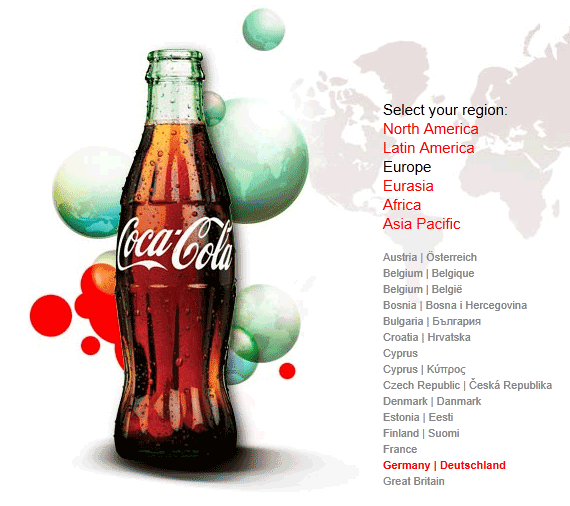
2. Match Local Currency
Experiment with another currency based on a region or country. You may want to keep it simple and try it on one popular product or landing page. Measure sales in combination with location – are the conversion rates any different if you display the currency of the visitor’s country?
Etsy.com does this well by displaying a wide variety of currencies for the products on sale. Here is a search for “Star Wars” jewelry from London, note prices are in GBP:
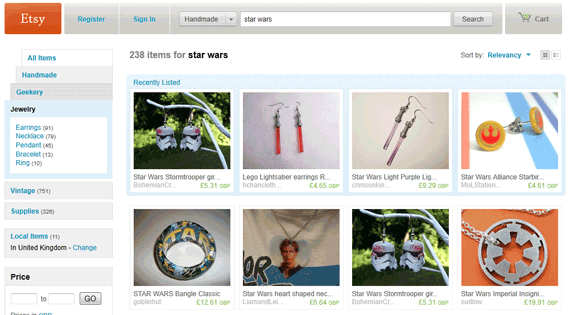
And the same search from Brazil shows the prices in BRL:

3. Evaluate Serving Local, Relevant Offers
You can also test matching the offer on your pages (product, service, message, etc.) to the visitor’s specific location. This sounds simple but requires careful thought and planning.
Measure funnel performance for visitors that are geo-targeted versus a control group – are people finding it helpful or confining in a way? Statistically, do visitors served with local offers differ in behavior from those asked to choose their location? Test it!
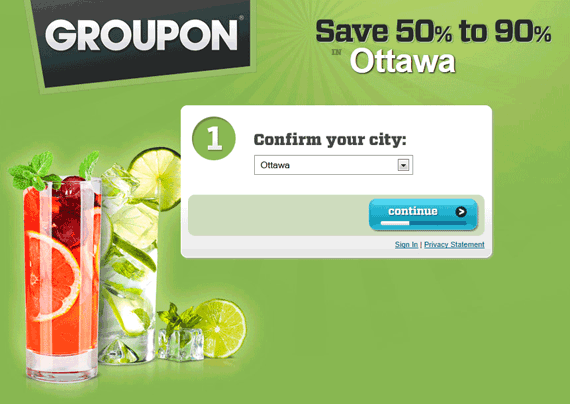
Another common issue is product or service availability for certain countries. Sometimes, you can only sell in one country, and informing your international traffic of such is considered good practice.
Why create a negative customer experience by showing something they cannot buy? Create anticipation instead:
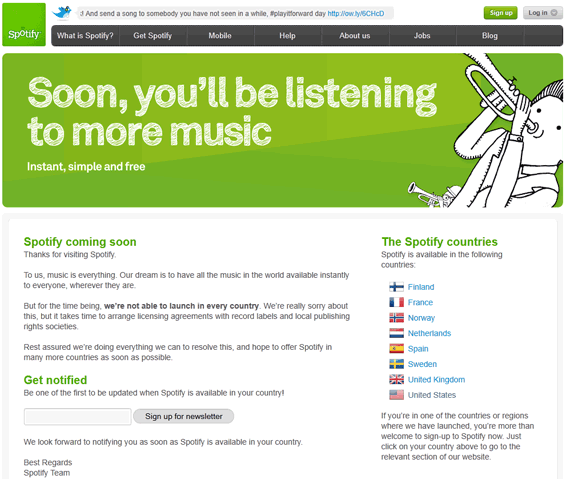
4. Match Paid Marketing Campaigns
Geo-targeting allows you to run different campaigns in different locations. Your ads might be served all over the world, so try varying in their marketing message according to the segment and audience location.
Is the marketing message on your site the same as the geo-targeted ad? Experiment with sending traffic from a geo-targeted banner to a geo-targeted landing page (in language, currency, offer, etc.) and to a generic page – what converts better?
5. Evaluate Visual Elements
As with any Split or Multivariate testing, modification of visual elements can make a big difference. Similarly, testing design elements based on the visitor’s location may provide better (or worse) conversion rates.
The way bright colors are interpreted by one culture on side of the planet may be vastly different from another. Think of holiday themes or national flags.
Here is Marriott.com as viewed from France:

Here’s the same site, but from Japan:

Even without understanding the content, the visual difference is significant. Also, note that the initial form on the page for the Japanese site is different.
Another example is HP.com from Egypt. Note the right-to-left changes and the language in the images.

The Italian version:
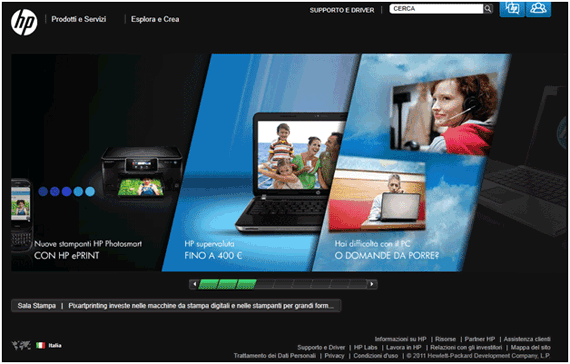
It gets very interesting in the “Special Offers” page on Skype.com.
Below are screenshots of the Special Offers page from the USA, Holland, and Sweden, in that order. There are significant differences here, not only in design but the offer as well.
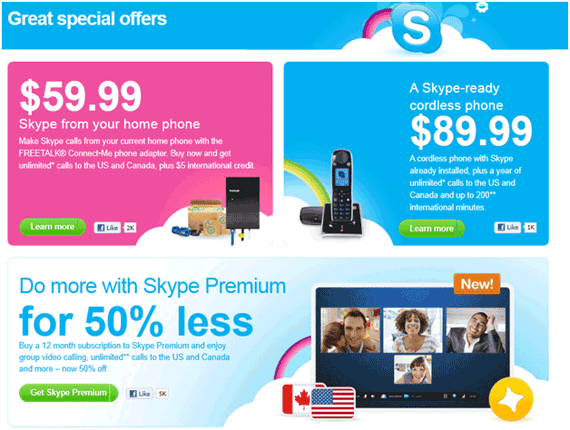

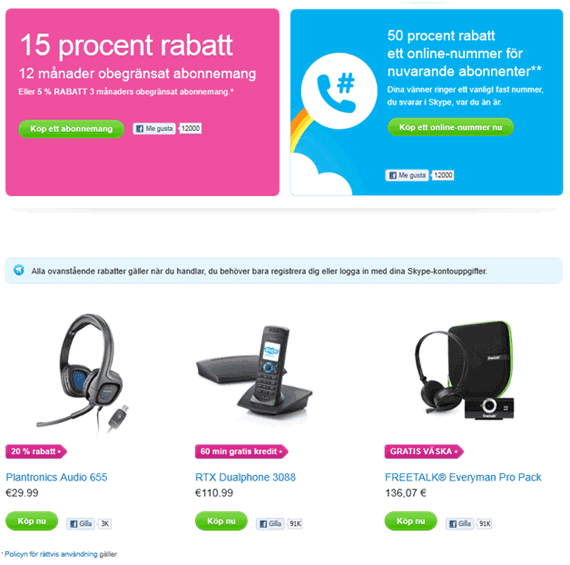
Each page features different languages, currencies, and different offers based on the location of the user.
How to Geo-Target Your Pages for Testing?
Ok, so how do you test location-based assumptions? There are a few ways. Some are more coding-heavy, while others are a little easier. The platform can impact how you test as well. For example, Google Ads allows you to create multiple ads right on their platform.
1. IP Redirect
To keep things simple, you may try IP-based redirects on your server. You can set up simple redirects based on geo-location, using .htaccess or httpd.conf on your Apache server (mod_geoip).
The GeoIP API (MaxMind) will enable you to quickly configure your server to divert traffic according to the originating IP. Your web analytics and optimization should do the rest. All you need to make sure it that you have a couple of landing pages to test your assumptions on.
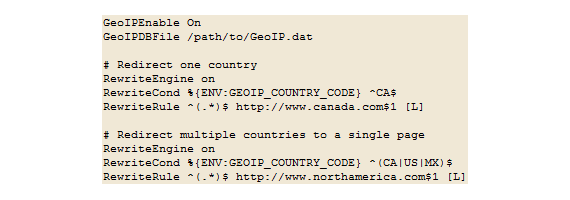
2. Pay-Per-Click Advertising (PPC)
Another easy way of testing geo-location is using a PPC platform such as Google Ads or Facebook Ads. You can set your campaign targeting to very specific locations and languages, as well as set the destination URLs of your individual ads.
Keep in mind, this will require a set of landing pages for each campaign, but delivers results very quickly. You may be able to run a fast, data-rich, and location-based conversion analysis with little more.
3. Geo-Target Domains / Subfolders
Another method is following Google’s Webmaster guidelines for country segmentations and either using subdomains or subfolders for specific countries and languages. This assumes that you have a generic TLD (.com, .org, etc.)
For example, es.example.com or www.example.com/es/ for Spain/Spanish. This might be the better local SEO solution because it also means that the subdomains or subfolders you specify will be shown in local searches on Google, based on TLD.
The downside is that it requires a fair amount of work to set up, and might not work well with your branding efforts internationally. An important note about this method is that it does not solve the problem of language, but only the country’s location. So if your service or product is available internationally, you probably shouldn’t limit the geographic location for which Google serves results.
Nonetheless, this approach serves as a good platform to initiate conversion optimization on those segmented pages or sites.
4. Geo-Target Content
For content-specific items, and multivariate testing, geo-targeted placements and elements will rely on your current traffic flow and allow you to run these experiments without the PPC overhead and an international SEO strategy.
There are several options:
1. Coding
Use PHP, JavaScript (and/or more) to query a geolocation database, and perform display logic accordingly. You will find numerous examples on the web to accomplish this. It’s fairly simple if you’re comfortable with going behind the scenes.

2. Web Services and Tools
Google’s Optimize supports simple geo-targeting of web elements, so it’s an easy way to get started. You can test based on city, region, metro, or country. (But not language.) Unbounce offers this feature on premium plans.
You can also use Omniture (from Adobe.)
How to Monitor Geo-Targeted Conversion Tests
Having initiated a geo-targeting conversion experiment, you are faced with an inherent problem: how can you verify what works?
One option is to ask people that are located worldwide to browse your targeted pages and inform you of the results. Another, far more convenient method, is to use a “global geo proxy network” that allows you to browse the web from different global locations.
There are several services available that allow you to choose from over 100 worldwide locations including countries and cities.
The easiest and most reliable to use are browser extensions that enable you to simply select a location from a dropdown menu and browse as usual.
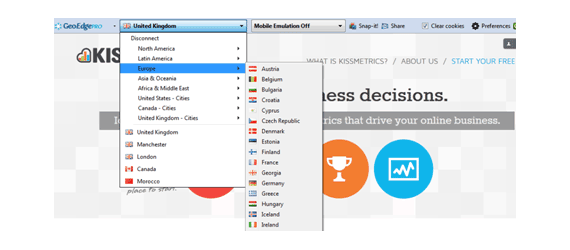
Global visibility tools such as proxy network services encompass many benefits for the process of geo-targeted conversion. Some are:
- See for yourself that it actually works.
- Run through the funnel and verify all the settings are correct.
- Personally inspect issues, such performance and latency, that may affect your conversion. If you measure Page Speed you may discover that distance=latency=low conversion.
- If you advertise on your site (Google Ads, etc.) you might want to see what ads are displayed on your site when viewed from different locations. It may be a factor deterring or contributing to conversions.
- See what your competition is doing in other markets. Find out the relevant offers/interests/deals for a specific location even if you’re on the other side of the planet. Use that data to come up with your next winning design or offer and modify your test accordingly.
Geo-Targeting: Frequently Asked Questions
What is geo-targeting?
Geo-targeting is when a search engine identifies the user’s location via their IP address, WIFI, or GPS data, and serves up content that is specific to that location. For example, if you live in Kansas City and Google “beauty schools near me,” a list of beauty schools in the Kansas City area should appear in the search results.
How can geo-targeting help increase conversions?
There are five ways geo-targeting can help increase conversions: translating content into new languages specific to the location you’re targeting with your content; currency matching; serve local, relevant offers; adapting your marketing message to the culture of the location you’re targeting with your content, and using different designs and color patterns depending on the location you’re targeting.
How do you geo-target your pages for testing?
Some options for geo-targeting your pages for testing include IP redirects, PPC campaigns, geo-target domains/subfolders, and geo-targeted content.
What are the options for geo-targeting content?
The options for geotargeting content are coding, web services like Google Optimize or Unbounce.
Conclusion to Increasing Conversions with Geo-Targeting
Testing geo-targeting is simple and beneficial to most websites, advertisers, and publishers, as well anyone using PPC campaigns or SEO. Not only does it enable you to match the most relevant content to your visitor, but geo-targeting is also a great way to experiment with conversion rate optimizations. I’ve presented a few ideas here, but the options are virtually limitless.
Do shoppers in Alabama respond to the color red, while those in Pittsburgh prefer yellow and black? Does showing Spanish language ads improve conversions for ads in California? There’s only one way to find out — test it.
Take advantage of monitoring tools that allow you to browse from different countries worldwide to better understand your competitors. You might discover opportunities to make your conversions soar.
Have you tested geo-targeting? How did it impact your conversion rate?
from Neil Patel https://ift.tt/3xHdbtz